Revell of Germany 1/72nd Scale He-177 Greif (Griffon)
Brief Subject Background: The Heinkel He 177 Greif (Griffin) was the only operational long-range bomber to be flown in combat by the Luftwaffe. To reduce drag in the design to meet speed (310 mph at 18,000 ft) and diving bombing specifications required by the RLM, Heinkel's chief designer, Siegfried Gunter, employed a unique engine layout on each wing consisting of a pair of DB 601 liquid-cooled 12-cylinder engines mounted side by side in a single nacelle powering a single 4 bladed propeller via a complex drive shaft/reduction gear design. The initial engine/drive system was prone to overheating causing numerous operational engine failures and fires; so many in fact that the aircrew that flew them nicknamed it the Luftwaffenfeuerzeug (Luftwaffe's lighter) or the "Flaming Coffin.
This model was built OOB with the addition of PE gun sights for the rear and front machine guns, antennae added from pantyhose nylon thread and Eagle Strike/AeroMater decals. This A/C is a He-117 A-3 of II/KG 40 operated out of Bordeaux, Merignac France 1944…well, kind of. The paint scheme is correct but I completely screwed the pooch on the fuselage codes, they should read F8 white F black M…a mistake that I didn't catch until I had the final flat coat sprayed on…too many projects going at once I suppose. The Fritz X missile under each wing were designed to be used against armored shipping targets and was steered by radio control from the mother aircraft. An easy assembly process and good over-all fit -even the “green house”, made this model was a joy to build and it looks good on my shelf even with the wrong code letters.
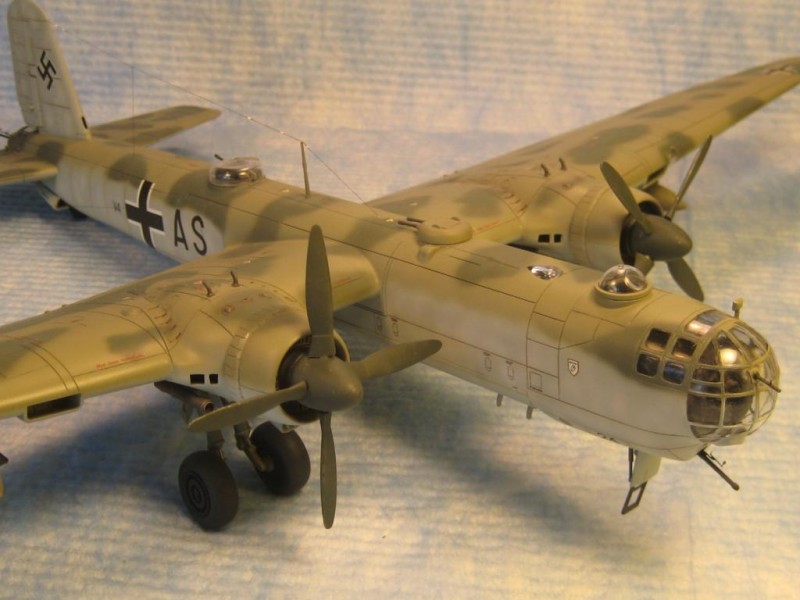
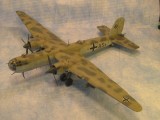

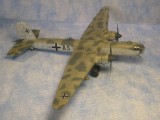
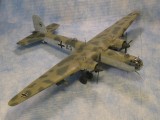


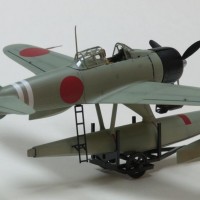
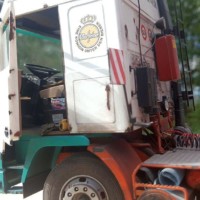
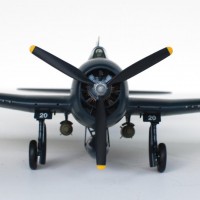
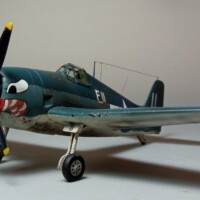
Beautiful build, Erich...nice paint job.
that's quite spectacular
A great build of a nice looking aircraft and an interesting subject, typical of the mindset in Germany at the time,I mean two engines powering one propeller what's the point in that ?, any Nazi designer only had to look at the Lancasters and B17's that were flying overhead every night and day to realise that four engines strung out across the wings worked perfectly well, in the end all they ended up with was a white elephant that was too costly and complicated to build and never really worked any way,probably for the best I suppose...
N.
Yeah i agree with that Neil. Lucky for us it didn't work out. Dunno if the He177 could carry a bigger payload than their HE111's or Dornier Do17's tho'?
I believe that part of the reason for this had been political. Heinkel was very well aware that the next logical step after the He 111/Ju 88 setup would be a four-engine heavy bomber. However, the Nazi government wouldn't approve of such a programme because it would have occupied so much industrial capacity (1 heavy bomber = 4 fighters etc.). So the He 177 was something in between, a four-engined heavie carefully disguised as a twin. And, as it turned out, not backed by sufficient production capacity. Weird indeed.
Great build and very interesting plane! I like it a lot...
cheers
Stunning rendition Erich! I have this in the stash, and i'm tempted to make it my next build (after seeing yours). There is loads of great internal detail on this kit, especially the cockpit area. Didn't they go on to make an improved 177 with 4 engines? Or was it a proposed design - this is ringing a bell in my head following Neil's comment about the engine configuration..!
I believe you are thinking about the Messerschmitt 264 "Amerika Bomber". Looks somewhat similar to the He-177 but had a twin tail. Outside of that, the only other four engined German bomber that I know of is the FW-200 "Condor" (which was not really a bomber. If there was a four engined version of the He-177, I would love to see a picture of it.
It was called He 277 and here's the photo of it:
http://www.aviastar.org/air/germany/he-277.php
That is too cool! I wonder what it would take to convert this kit to a 277?
Apparently...
http://www.antaresmodels.com/verReview.asp?id_review=1228703084
Seamus, most of this has been covered by subsequent comments i've been too slow to respond to! My old book/reference, which i've had since 1978 had a small paragraph and picture of the He 274. This was a He177 with 4 seperate engines, and the twin tail (like a Lancaster). It was developed by Heinkel in France in the face of instruction by Goering to let it go following all the probs with the He 177. 2 prototypes were completed by the French in December 1945, and actually were put to use as high altitute test/research aircraft. As Martin and Erich pointed out the plane was also named as the He277! But as far as i am aware there were no He 277's actually constructed. Germany had other 4 engined aircraft on the drawing board via designs from Dornier and Junkers, but again i don't think they ever built any.
Beautiful job on that. Extra clean, great paint. The clear nose is blended perfectly.
The object was to get two engines for the drag of one, something like the Dornier DO335, but these were side to side. Heinkel could have used 4 engines but was always looking to get a step ahead. (See surface evaporation cooling). The 4-engine configuration was already at it's peak. After the proven failure of this attempt, it was offered to go back to a 4 engine setup, but I believe it was Goering that stubbornly nixed the idea.
So nice to see one of these built! You've done a beautiful job on it, I like the paintjob a lot.
And if you hadn't told us about the lettering, nobody would have noticed 🙂 !
Regards
Magnus
Wow! This one makes other 1/72 He-177's look like...ehrrrrm ...models!
Nice!
Hi All, Thanks for the kind words about my He-177. I’m glad you liked it.
If you are interested, I dug up some more information on this subject:
Originally, in 1937 the specifications for the New bomber was be able to carry a bomb load of at least 1,000 kg (2,200 lb) over a range of 5,000 km (3,100 mi), and possess a maximum speed of not less than 500 km/h (311 mph) at altitude. This was a tall order; be able to outrun any modern fighter and outperform, by a considerable margin, any bomber then in service. To top it off, right after the prototype was completed, the Luftwaffe High Command (OKL) also required the plane to be strong enough enable it to undertake medium degree diving. Basically, these guys (RLM, OKL) shackled the 177 (like almost every other AC in the Luftwaffe service) with jack of all trades limitations instead of building a single purpose built design. The He-274/277 long range bomber design was to employ a conventional four engine layout using super charged BMW 803 power plants. There are some great photos and development information about the He-177+ prototypes, He- 274/277 and the six engine He-264 “America bomber” in GERMAN HEAVY BOMBERS, Manfred Griehl/Joachim Dressel Schiffer PublishingLtd,1994.
Happy Modeling,
Erich
all i can say after all that is beautifully done Erich
Erich, thanks for helping me get on this site and for being a great friend.
First one I have seen built, very well done on a rarely seen aircraft in any form. And so glad the the Nazi high command didn't allow it to really go into production. One of many great ideas that Heinkel had going on with their designs. That never had a chance. Good for the Allies.
Chuck
Fly Navy